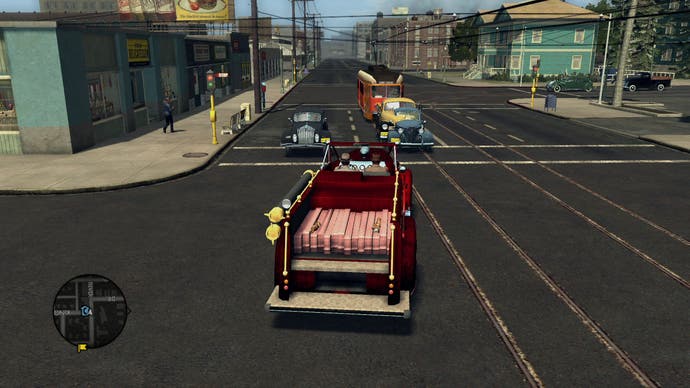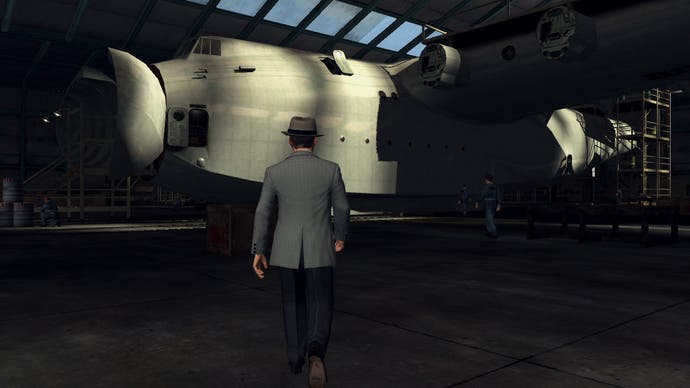L.A. Noire: Nicholson Electroplating
Boom town.
The faces look nice enough, but the game's insistence on showing off that technology can be laughable. Most lying suspects "hide" their guilt with all the subtlety of a Charlie Chaplin character with black pepper up his nose.
My mom happened to be in town while I was playing Nicholson Electroplating for this review. She caught a glimpse of Cole Phelps walking in place after he hit a wall, and she giggled. She said, "This reminds me of Clutch Cargo," a 1960s cartoon with famously crude animation. So much for faces.
I would like to see Rockstar executives talk about the incredible realism of L.A. Noire's characters while behind them, a huge screen shows what Cole Phelps looks like when he is climbing a ladder.
Then there is the Truth/Doubt/Lie interrogation system. You must choose one of these options each time a suspect answers one of your questions. Choose the right one, and you hear a three-note jingle of success. Otherwise you get the sad music.
The internal logic that determines which choice is correct can be outrageously obscure. There have been times when I thought the game should be called L.A. Sad Music.
It's a recipe for one of the silliest games of this console generation - except that in practice, it's one of the best. Incorporated into the whole, all this stuff works.
Pounding pavement for clues in the Hall of Records is exciting, because you have a feeling that this is where you'll finally peel back the curtain on those shifty insider types. It doesn't seem mundane; it seems like the world is about to change.

And while the frustration of a misfired line of questioning never feels good, a little pain is OK. Because over time, the ever-present potential for failure ratchets up the tension of every interrogation. (The capriciousness of the system has the added benefit of being honest: luck and gut instinct play a part in real-life interviews, too.)
Nicholson Electroplating doesn't benefit from this larger flow, and as such, the inanity of L.A. Noire's component parts are laid bare.
The case brings you to an airplane hangar to search for clues. The logic seems to be that if hunting for clues in a small room is fun, then hunting in an enormous building must be a rare treat! And certainly not sadistically boring!
The car-chase feature has also been isolated and turned up to 11, insofar as it is a longer-than-usual car chase. Your partner screams that you need to get closer so he can take out the guy's tyres.
He fires off shot after shot, but he never hits those tyres. Because if he did, you would never get to experience the splendour of this lengthened car case. Truly, it is of somewhat greater duration than you are accustomed.
Also, there's this one part where you shoot a bunch of guys, and there sure are a lot of guys.

The case isn't entirely misconceived. Recognising the need to have some larger stakes as a driving force behind the individual set pieces, the developers incorporate the great Hollywood figure of Howard Hughes - specifically, his "Spruce Goose" boondoggle - and the lesser-known O'Connor Electro-Plating Corp. explosion, which happened much as the game portrays it. (The O'Connor incident is recounted with entertaining colour in a 1947 Time magazine article.)
Yet the strength of L.A. Noire is myth-making, and this feels closer to myth-borrowing. That's not to say that L.A. Noire proper isn't also inspired by actual Los Angeles lore; it is. Yet in the broader game, over the course of many hours, those bits of legend metastasise and intertwine and grow into a thriving experience of their own.
Nicholson Electroplating doesn't have time for that slow-burn organic process. It attempts a brute-force attack on greatness and comes up short. Yet the contrast between this expansion and the main game sheds a revealing light on the thoughtful craftsmanship of experience that makes L.A. Noire such a treasure.
